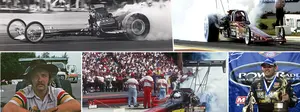

Racer's Scrapbook: Jim Dunn

 Jim Dunn has been racing for more than 60 years, accumulating a series of honor and wins – and drivers – first as a driver then, for the last 20-plus years, as the owner of a string of perpetually strong Funny Cars. Dunn, a former fire captain, keeps his competitive fire burning with a no-nonsense, my-way-or-the-highway attitude that nonetheless has earned praise from the many drivers he’s mentored into capable flopper pilots. He could teach an egg how to be hard boiled.
Jim Dunn has been racing for more than 60 years, accumulating a series of honor and wins – and drivers – first as a driver then, for the last 20-plus years, as the owner of a string of perpetually strong Funny Cars. Dunn, a former fire captain, keeps his competitive fire burning with a no-nonsense, my-way-or-the-highway attitude that nonetheless has earned praise from the many drivers he’s mentored into capable flopper pilots. He could teach an egg how to be hard boiled.
Despite the sometimes gruff exterior, “Big Jim,” as he’s known to his legion of fans and friends, remains one of the most approachable owners in the business, so when I asked if he’d share an hour of his time before Saturday qualifying in Brainerd to work with me on a new installment of Racers Scrapbook, I was not surprised that he was willing.
Dunn’s memory is keen and his love of his old cars is obvious in the dozens of images that make up the screensaver that takes over his computer monitor when he’s not tuning and tinkering, and he was happy to discuss them and the thick folder of images I brought with me from NHRA HQ. [Comments in brackets are mine for purposes of clarification.]

“My dad was a cowboy –- a bronc buster, actually -– so I rode a lot of horses in the summer at our cattle ranch in Montana when I was young, but my dad could tell that I liked cars more. Horses bite, I told him, so he bought me a ’39 Ford. I told him I’d never race it, but I raced it at the first stoplight I ran into. I street raced for a while and made some big money. I was hard to beat. I was the baddest. I had a couple of other cars, but this is my first serious race car. It’s a ’53 VW Beetle with the split window in back.
“This was 1953; I was 19 and I had started hanging out with Art Chrisman and all those guys, and they took me under their wing. Chrisman and [partner Leroy] Neumeyer shook their heads the first time they saw this car. It had a flathead Lincoln in it that I built and ran on 75 percent nitro and would run 121 mph. I sat way in the back; you can’t even see me. I built my first engine when I was 15; my dad asked me what I wanted for my birthday that year and I told him ‘a cam and three carburetors.’ I’ve always been pretty mechanically inclined.”

“This is the Dunn-Merritt-Velasco Fiat that I ran with Henry Velasco and Dewey Merritt. I built the chassis myself; everything is homemade on this car. It had a 5/8-stroker small-block Chevy, supercharged on gas, and won [class] at the Winternationals in ’63 and ’64 and was runner-up at the ’63 Winternationals [in Middle Eliminator, behind Doug Cook]. This is actually the second version of the car. This first one was really ugly and really heavy. Ready to start, without me in it, this one weighed 990 pounds.”
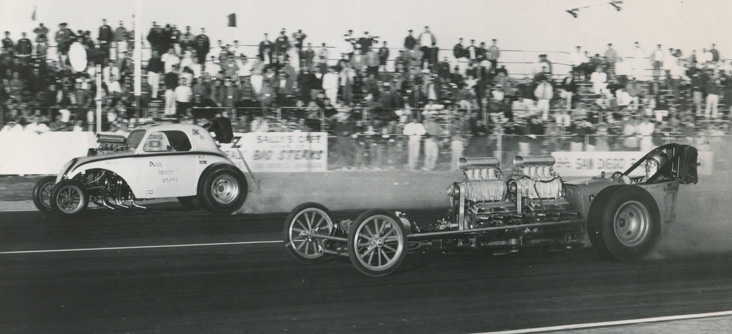
“Oh yeah, this is Ramona [Calif., against an early version of the Freight Train]. We put it on fuel to run this race, and ran it on fuel at the ’64 March Meet. We won that year on nitro, just like we did the year before on gas. Ramona was a funny place; they had a boulder as big as this trailer that you ran between at the finish line. I went there once and the wind was blowing about 30 mph but I wanted to run because ‘the Greek’ [Chris Karamesines] was there. I went 161, sideways through the lights.”
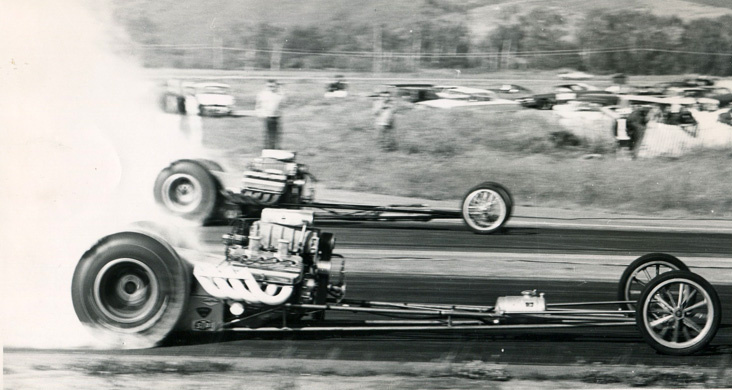
“This is the Dunn & Yates dragster, probably my third or fourth dragster, around 1967. I went to a dragster because you could get paid a lot more. The first car was really short and I didn’t like it, and told Woody [Gilmore] to build me one like ‘Snake’ [Don Prudhomme] and Pete [Robinson] had. It was so heavy that I came back at him screaming that it was heavier than my altered. He said, ‘How long was your altered?’ and I said ’72 inches.’ He said ‘This is 116; I’ve got a lot more steel in it. How much heavier is it?’ and I said, ’20 pounds.’ I liked my cars light.
"Smoking the tires like this was the way we went fast; we didn’t have slipper clutches yet, so the tires did the slipping. We were runner-up to the Hawaiian [Mike Sniveley driving] at the ‘66 Winternationals in the quickest side-by-side race.
“You can’t see it in this photo, but the car had a plate on the front end, like a wing. We set the record with this car one weekend in Salt Lake City and people started asking us how many degrees [of angle] we had it set at. I told them I didn’t know but they thought I was just [BS-ing] them. Truth is Al Yates was my partner on this car; he was a photographer for Drag News, and he went 100 feet out with his camera and we adjusted it until he could read the name. If you could have your name showing in a picture, you got a lot more ink because no one ran a body back then.”

“This is one of the first cars I had with [Joe] Reath. People called it ‘the Rainbow car’ because of the paint. It was all candy pearl and changed colors depending on the angle. We had three cars painted like that. I won the March Meet [in 1969] with this car. On this run, at Lions, the crew guy didn't get the oil filter screwed on all the way. Oooops.”
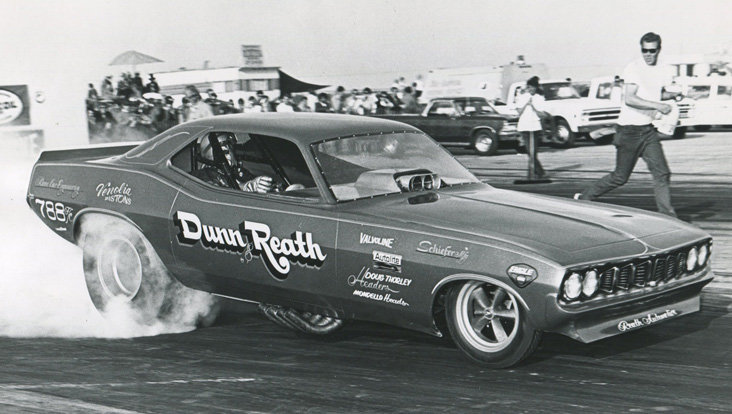
“This is my first Funny Car in 1971. Guys used to stop by Reath’s shop all the time looking for used parts so they could run their Jeeps and whatnot on nitro at Lions. I asked one of them, ‘Do they have a class there?’ and he said, ‘No, they just pay us appearance money.’ When he told me how much they made, it was like what we [Top Fuel] were getting for being runner-up, and when you ran Top Fuel at ‘the Beach’ you’d better be within a tenth of the record or you didn’t qualify. That’s when I decided to build a Funny Car. This is another Woody car. I told him I wanted it light, high-gear-only, with a quick change [rear end] in it. It was one of the first cars to have headers run over the framerails. People couldn’t believe it when we went to change heads between rounds and it was so easy. First time out in the car it set low e.t. at the Manufacturers Meet. Woody was about to go broke because Top Fuel was dying, but after I ran the car he got 20 orders [for Funny Cars] in two weeks.
“It was easy for me to get used to driving a Funny Car; it was like driving something between the altered and a dragster.”

“[Son] Mike worked on all of my cars probably from the time he was five years old. He got his license in my car, running on alcohol. He was like me, pretty mechanically inclined right from the get-go. He got pretty good and starting asking to get paid for working on the car. I told him, “I don’t pay anyone,’ and turned him over to Roland [Leong]. I said, ‘Hey Roland, you want a crew guy who’s 17 but has 20 years’ experience?’ He said, ‘Send him over.’ “
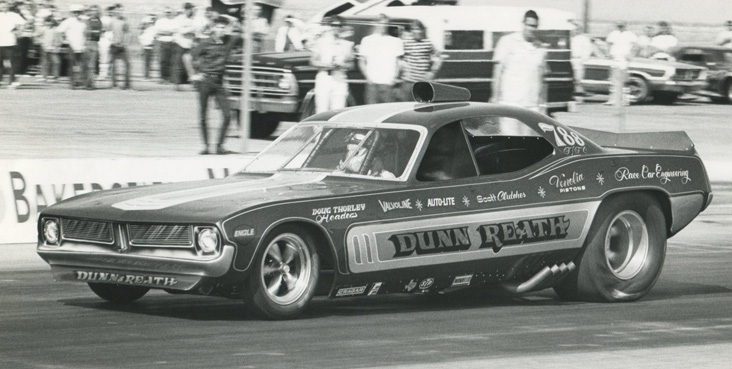
“This is the first rear-engined car. Woody built it for me; it was his idea. The first body I had made weighed 350 pounds because it had to be stretched. [Don] Kirby did it and I think he ended up using the mold because when I went to add that little scoop on the roof – to get cool air into the engine – I must have drilled through a half-inch of body. It picked up 5 mph right away.
“Why did I build it? That’d be like asking Jim Head why he tries something. I like different stuff. I had worked on a rear-engine car, a Javelin, for Doug Thorley a few years earlier. I was going to drive it but couldn’t get time off from the fire department. Bob Hightower drove it and crashed it at Irwindale; most of them crashed.”

“This is me and ol' Woody. Before the first pass we made at Lions I asked him how much weight I should put on the front end. He told me, ‘I engineered that sonofabitch; you don’t have to put any weight on it.’ First pass the front end came up four feet. I came back and said, ‘Woody, do you think I should put 10 pounds on the nose?’ He said, ‘Put 100.’ “

“I took the old mold body up to Mr. Ed [Wills] and had him make me a lighter version from the mold. This one weighed 50 pounds; it was much pretty much two-ply. This is the first run with the new body at Orange County. I didn’t even know the roof had come off until a guy at the top end told me, because the windshield stayed in place. We taped it back together with duct tape and ran the rest of the race.”

“You can see how we were trying to get air to the motor through the windshield. We didn’t really know where we wanted them at first, so one night we went to Long Beach [Lions Drag Strip] and decided to ‘wind tunnel’ it. I had a guy at the starting line and one guy at the turnoff. As soon as I staged the guy on the line threw water on the hood, I made the run, and the guy at the other end looked where the water went. That’s how we decided where to put them. They worked really well.
“The guys are pushing me back because I didn’t always run a reverser in the car. Because the engine was so far back, I could run a two-speed or a reverser, but not both. Most times at match races I’d put the reverser in it so I could do quarter-mile burnouts. I didn’t use a reverser until the rules said I had to have one. The hatch in the windshield was my emergency escape; it was soldered in so I could pop it off if I needed to get out in a hurry.”
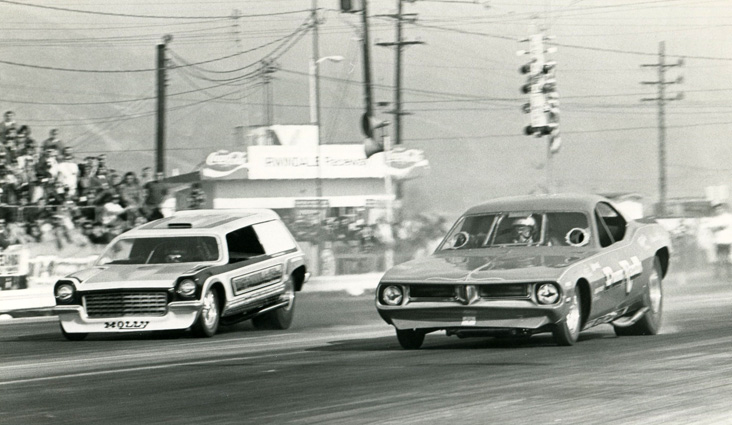
“[Dunn racing Dave Bowman’s rear-engined California Stud Vega panel at Irwindale] A bunch of guys tried to make it work, but they were hard to drive; my feet were pretty much on the front axle and if you didn’t stay ahead of it, you were going to crash. People ask me why I never crashed and I tell them I was chicken.”
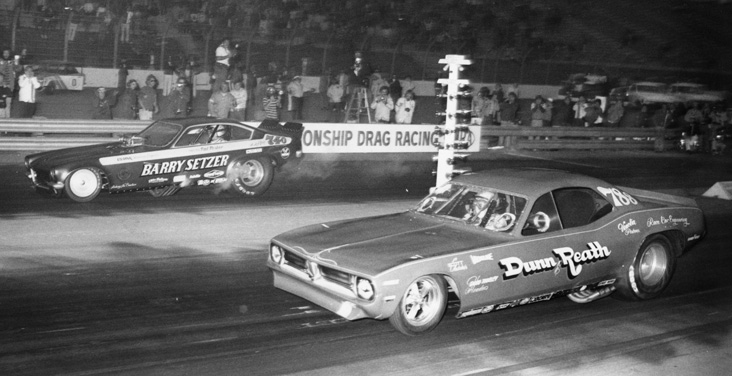
“Winning [the 1972 Supernationals] felt good because it was a unique design and something I believed in. Beating Pat Foster in that car was something, because it was the best car out there – that was the Schumacher car of its day; high-dollar, and [Barry Setzer] was a nice guy -- but he red-lighted. Sometimes that happens; I bet I won 80 percent of my races on holeshots, and sometimes you’re going to red-light. I didn’t even know he red-lighted at first.
“It’s the first and only rear-engined car to win a race, and will probably always be. I can’t see anyone every trying it again.”
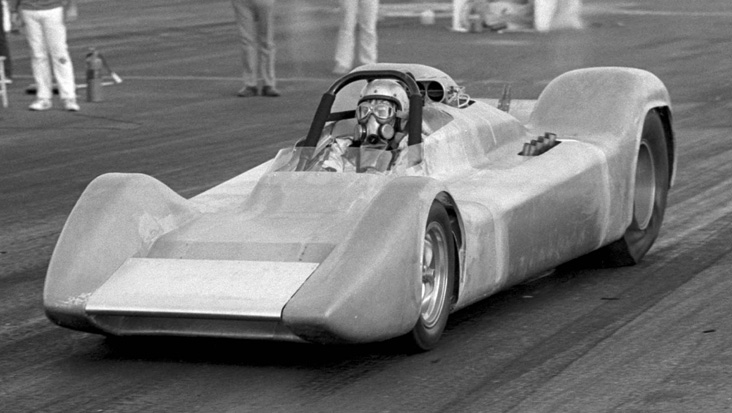
“This is just the rear-engined car with a dragster-style body on it. [Doug] Kruse built the body in two weeks. We debuted it [at the 1973 Grand American race at Orange County Int’l Raceway]. We actually built it because [Don] Garlits; he was getting all the advertising with his [Wynn’s Liner streamliner]. We didn’t think it would really work and never ran it until we got there. We qualified and Garlits didn’t and we even won a round -- beat [Don] Johnson in the first round – and went a couple of rounds in the Funny Car, too. It would take us about 30 minutes to switch it over; just unsnap the body and change the headers.”
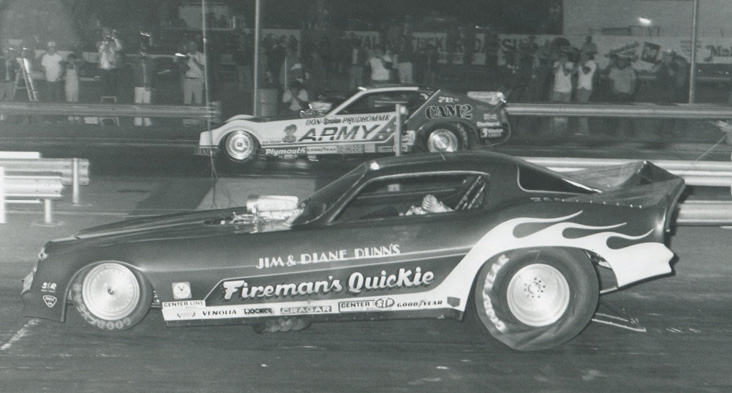
“This is 1979, the first car I called ‘Fireman’s Quickie.’ It was kind of a firehouse joke thing. We all know what a quickie is; everyone loves a quickie, but the only ones who got more divorces than firemen were police. Anyway, we weren’t sure how people would feel about [the name], but we decided to make some shirts. At the first race we had a girl who wanted a shirt really bad; her boyfriend bought it for her and she held it up, turned it around and said, ‘Oh it has a picture of a car on it too.’ I knew we were in.”

“I drove for Roland once, and made the quickest run ever [a highly-disputed 5.85 at Orange County Int'l Raceway's Super Bowl of Drag Racing event in January 1981, when the best run in history a was a 5.92] but they threw it out. Mike was down in Australia driving and Roland needed somebody to put the car together and test it. The first pass, he didn’t like how slow I backed up. ‘Back up faster.’ You got it. He didn’t like how I did the dry hop, because I did little ones. ‘I want longer dry hops’ You got it. Then he noticed that even if smoked the tires on the dry hop it wouldn’t do it on the run. I’d hold the brakes on the launch. On one run, I blew the blower because the other guy [Bob Pickett, I believe] took too long staging. I was getting out of the car at the other end to talk to him and Roland came up and said, ‘No, I’ll do it.’ And he went over and told off the guy. I thought that was pretty cool.”
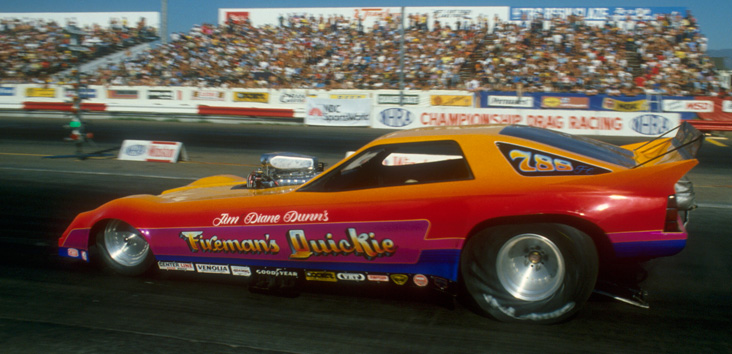
“1981 was a good year. I won the Finals at Orange County and was runner-up at Indy to the Max [Raymond Beadle]. I had always hoped to win a big race. I won the March Meet [in 1969] when there were 125 Top Fuelers and I won the Finals twice, at Orange County and Ontario [Motor Speedway; actually the Supernationals, but it was the season-ending event] and I thought it would feel really good, but to me [winning the final round] felt pretty much the same as winning the first round. That was a pretty big disappointment.”

“A lot of people thought this car was ugly. The body was just a wedge, no headlight cutouts or anything, but look how high that rear wing was; he [body builder Bruce Iversen] was ahead of his time. The bodies were cheap, too. The paint was kind of ugly. We went to [painter Tom] Stratton’s shop and there was only one car uglier than this. You can’t make everybody happy.”

“This is the first major sponsorship I had. Lucille Lee was driving the TR3 Top Fuel car for [Marc] Danekas. He called me and told me ‘We want you to race her at Orange County. We want you to teach her every dirty staging trick you know.’ They paid me $3,000 -- $1,000 a run, same as I got for match racing – so I’d go in there and stage fast, stage slow, stage then back out, hit the throttle with the clutch in so she would red-light. They were so happy they decided to sponsor me.”
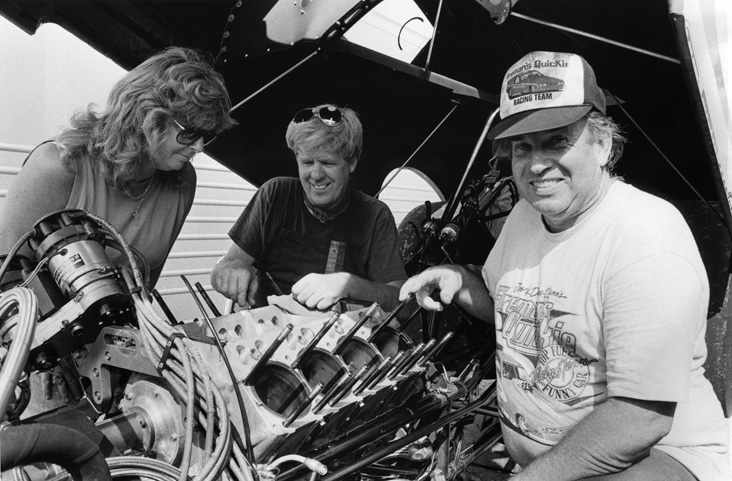
“My beautiful wife Diane and my crew guy, Joe Turner. That’s all I had for years out there match racing. Me, her, and ‘Goofy.’ Diane and I have been married over 40 years; I took her to her first drag race. She didn’t know anything. She thought it was like a hobby, like a guy taking his boat to The River once a month. She’s packed parachutes, mixed nitro, she’s done it all. ‘Goofy’ was with me almost 20 years, but when we started to get sponsorship deals, he couldn’t put up with it all. I told him I couldn’t run without them. He quit, but we’re still friends.”
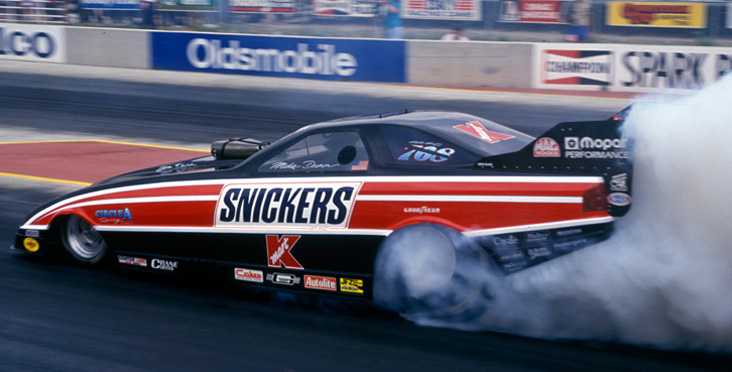
“Mike and I started driving for [wealthy car owner Ed] Abel in the middle of 1990. We won a couple of rounds at our first race, in Reading, then were runner-ups in Kansas [Topeka], then we won in Dallas and ran on the [5.]40s. I told Abel that winning that quick was the worst thing that could happen. It’s not this easy. We won four races with this car and had a lot of fun racing with each other. Mike was one of the best drivers out there and could give me feedback you might not see right away on the computer. Having unlimited money didn’t hurt either.”
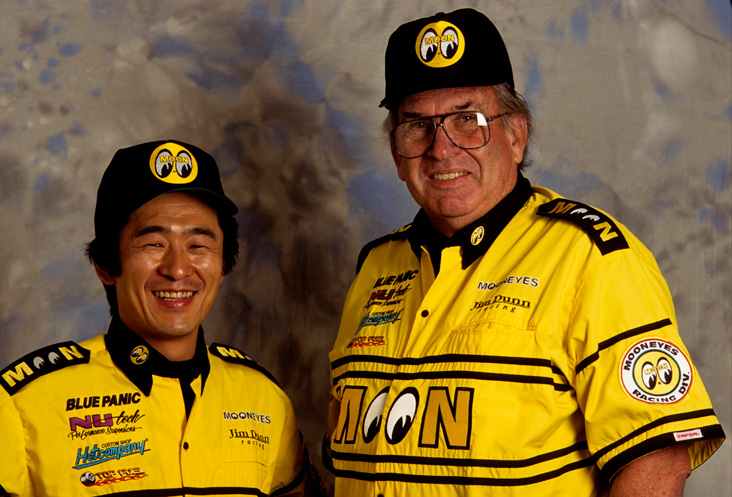
“We met Kenji [Okazaki] at Fuji [Speedway] when we were over there running our car [at the NHRA-led USA Drag Festival] in the early 1990s and he bought our car. He wanted to run it on alcohol. I told him that all of my cars were for sale, and that the cost was $18,000. He brought some guy over to look at and he said he thought it was only worth $16,000. I said “I agree with you; it’s not worth $18,000. It’s now worth $19,000. You want to try to chisel me down some more it’ll be $20,000. He paid me 19.
“He won the championship over there and wanted to drive my nitro car. I told him what it was going to cost and he came up with the deal. We took him to Bakersfield to get his license. He was pretty good right away, probably the best leaver I ever had; the best concentration for sure. He was a black belt in that wooden-sword stuff [Kendo?]. He would tell me, ‘If you’re slow, you’re hurt.’
“One time during qualifying, I think it was Houston, he took off and the steering wheel came off in his hands. I saw the car moving over and thought he must have gotten knocked out, but he got it back on and saved the car. He was good.
“I couldn’t get him to stage first. One time I got so mad I told him he needed to stage faster. He told me he staged as soon as the other guy did. I told him he needed to stage first. ‘Oh no,’ he told me. ‘He has more experience, The honorable thing is to let him stage first. I respect him.’ I told him, ‘Not here.’ He said, ‘OK, I go apologize to them then.’ “
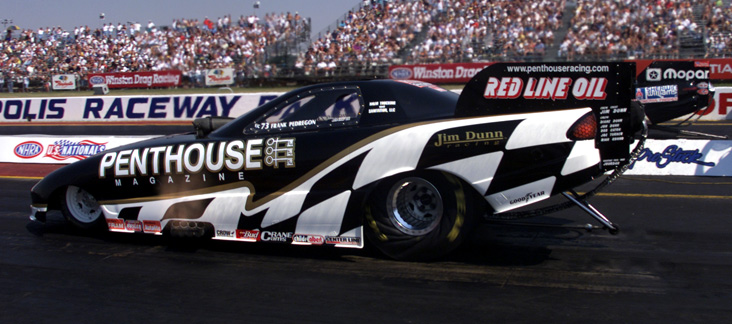
“Frankie [Pedregon] did a good job driving for us [1998-99]; we won three races together including Indy in ’99 with the Penthouse car. I always seem to run good at Indy. The year before I was tuning Randy Anderson and he was runner-up at Indy. The Penthouse deal came from a guy [Kelly McGrath] who was going to drive the car that year, but he had some eye problems. He’d popped his eyeball out one time in a dirt-bike accident and was being held in by some kind of [medical] rubber bands. I told him he had to go to an eye doctor and bring me a note that he could take three Gs plus and minus in four seconds without his eye hurting. He couldn’t do it, so Frankie ended up driving the car.
“Frankie had only driven an A/Fuel [Dragster] before that but we turned him into a good Funny Car driver. I used to think I could turn anyone into a good driver; I don’t think that anymore.”
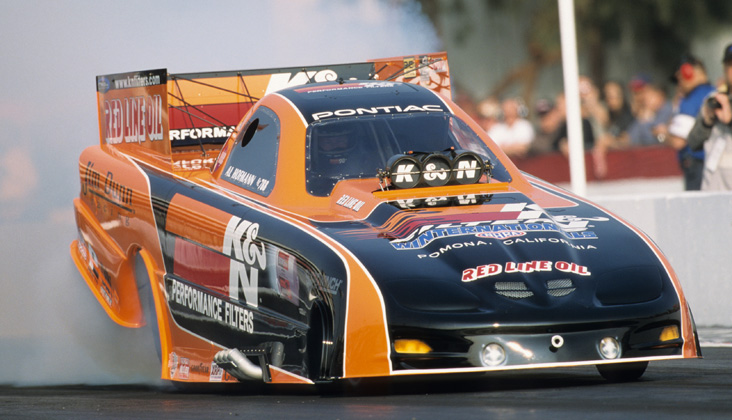
“Frankie ended up wanting more money than I could pay him, so I got Al Hofmann to drive my car. He and I got along real good together because he had been an owner/driver and knew how it all worked and what stuff cost, and he could give me the feedback I needed to tune the car.”
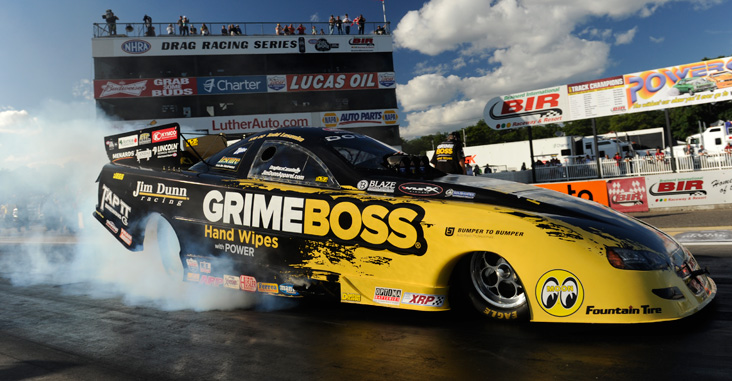
“Todd Lesenko drove for us one year [2012]. We threw a lot of bodies off that year. I think we still have the record for altitude. It must have gone 150 feet into the air at Indy. He just had a lot of problems driving the car. We changed pedals, everything. We just couldn't make it work with him.”
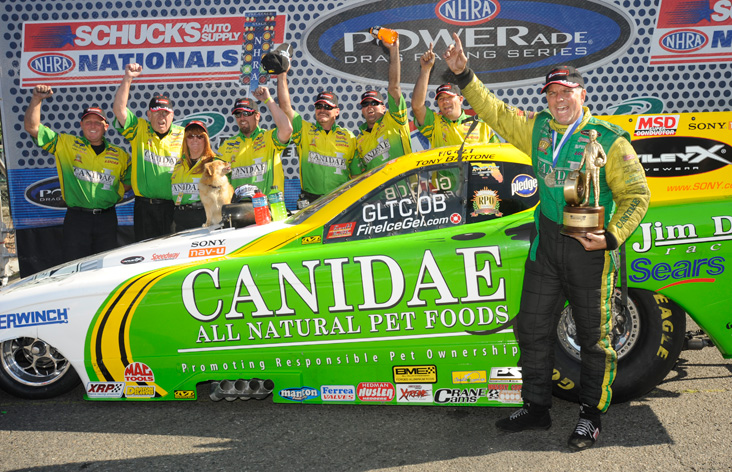
“This was a good day, Seattle in 2008, our last win, with Tony [Bartone]. I always told people that I could run as good as anyone with half the budget, but that was when people were getting $700,000 not $4 million. I still enjoy racing. I have two choices: I can quit or pull my horns in.
“To me, these days, qualifying is a win. You just change your mindset. You win a round, it’s even better. My car will run .90s all day long, but the other guys are running .80s. It’s tough out here.”
Thanks to "Big Jim" for sharing his memories and stories with us. OK, now we're Dunn. See ya next week.
Phil Burgess can reached at pburgess@nhra.com



















































